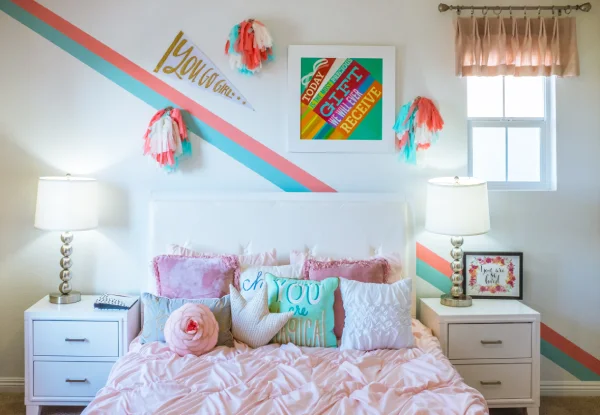As a parent, nurturing your child’s growth and development goes beyond providing them with nutritious meals, quality education, and a loving environment. It also extends to the spaces they inhabit, particularly their bedrooms. This article aims to offer ten essential tips to help you design your child’s room, creating a sanctuary that reflects their personality and interests while providing a conducive environment for learning, play, and restful sleep.

Understanding the Importance of a Child’s Space
The first step in designing a children’s room is understanding the significance of this space in your child’s life. A child’s room serves multiple purposes. It is a place for rest, study, play, and to express their creativity. It is their little corner in the world where they can feel safe, secure, and in control.
In addition to providing a practical function, a child’s room also plays an important role in their cognitive and emotional development. It offers a venue for children to express their individuality and cultivate a sense of autonomy. The manner in which a child keeps and decorates their room can serve as a reflection of their personality, interests, and aspirations.
The Basics of Kids Room Decor
When it comes to kid’s room decor, several factors come into play. Firstly, the room should be functional, catering to your child’s needs and daily activities such as sleeping, studying, and playing. Secondly, it should be aesthetically pleasing, providing a visually stimulating environment that can ignite your child’s imagination and creativity.
The room’s theme should resonate with your child’s interests, whether it’s dinosaurs, space, fairies, or sports. A themed room can make your child feel more connected to their space and can provide a fun and exciting backdrop for play and learning. Wallpapers, beddings, and decor items that align with the chosen theme can help bring this vision to life.
Incorporating the Child’s Personality into Room Design
One of the most crucial aspects of designing a children’s room is to incorporate your child’s personality into the design. This ensures they feel a sense of ownership and connection with their space. Engage your child in the planning process. Ask them about their preferences, their favorite colors, characters, and hobbies.
The room’s decor can mirror their temperament. For instance, a child with a vibrant, energetic personality might enjoy bold, bright colors, while a child who is calm and introspective may prefer softer, muted shades. To make the space truly unique, consider incorporating handmade or customized items, like a neon name sign that displays their name or a favorite quote.
Selecting the Right Color Scheme for Your Children’s Room
Choosing the right color scheme for your children’s room is pivotal in creating an environment that is both visually pleasing and conducive to your child’s well-being. Research shows that colors can significantly impact mood and behavior, making color selection an essential aspect of room design.
Avoid overly bright colors, as they can be overstimulating and may disrupt sleep. Instead, opt for calming shades like pastel blues, greens, or lavenders. For older children, consider incorporating their favorite colors or using neutral tones as a base and adding pops of color through accessories and decor.
According to Chris Diprose, CEO of Voodoo Neon, “The use of neon signs in children’s rooms has become increasingly popular in recent years. Neon signs not only add a touch of whimsy and personality to the room, but they can also emit a soft and soothing glow, perfect for creating a comforting atmosphere at night.”
Functional Furniture Choices for a Child’s Room
While aesthetics are important, functionality is equally crucial when it comes to selecting furniture for your child’s room. Pieces that grow with your child, such as convertible cribs or adjustable desks, can be a smart investment.
Ensure that the furniture you choose is sturdy and durable, able to withstand the wear and tear of daily use. Opt for storage-friendly pieces, like beds with built-in drawers or bookcases with ample shelving, to help keep the room tidy and organized.
The Role of Lighting and Neon Name Signs in Kids Room Decor
Neon name signs are a popular trend in kids’ room decor. These signs not only serve as a personalized decorative element, but they can also act as a night light, producing a soft, ambient glow that can help ease your child’s fear of the dark. For a wide range of creative and customizable neon name signs, you can explore neon kids room decor (like these). They offer an array of captivating designs, from whimsical animals to charming script fonts, allowing you to find the perfect neon name sign that resonates with your child’s interests and preferences. These neon signs not only add a unique touch to the room but also provide a comforting and soothing glow that creates a cozy and inviting atmosphere during bedtime.

Creative Storage Solutions for a Clutter-Free Children’s Room
Keeping a child’s room free of clutter can be a challenging task. Kids accumulate a lot of stuff – toys, books, clothes, and more. Creative storage solutions can help keep the room organized and make cleaning up a breeze.
Consider multi-purpose furniture that doubles as storage, like ottomans or benches with hidden compartments. Wall-mounted shelves or pegboards can also be a great way to utilize vertical space. For small items like toys or art supplies, use storage bins or baskets that can easily be pulled out and stowed away.
Safety Considerations When Designing a Kids Room
Safety should be a top priority when designing a kids room. Avoid furniture with sharp edges or unstable pieces that could tip over. Ensure that window blinds don’t have cords that could pose a choking hazard, and install safety locks on windows and doors.
Make sure all electrical outlets are covered, and keep any cords or cables neatly tucked away. Use non-toxic materials and paints wherever possible, and ensure that all toys and decor meet safety standards.
Final Touches: Bedroom Decor to Make Your Child’s Room Special
The final step in creating a beloved space for your child is adding those special finishing touches. These might include personalized items like a neon name sign, artwork created by your child, or a special memento that holds sentimental value.
Other decor elements like curtains, rugs, throw pillows, and wall decals can bring the room’s theme and color scheme together, adding depth and character to the space. Remember, the aim is to create a room that not only looks good but also feels like home to your child.
Conclusion
Designing your children’s room can be a rewarding experience, providing an opportunity to bond with your child and to create a space that supports their growth and development. Remember, the goal is not to create a picture-perfect room straight out of a catalogue, but a space that is functional, safe, and reflective of your child’s unique personality and interests. With careful planning and consideration, you can create a beloved space that your child will treasure for years to come.
[caf_filter id=’10609′]
